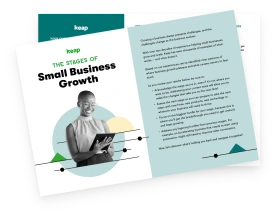At times, improving email open and conversion rates can feel impossible—constantly writing new copy can leave you feeling like a chicken running around with its head cut off.
In my role at Keap, which designs software to help small business owners create powerful email communications, is managing a team that relies on email and phone reach out for connecting with our customers. From experience, we completely understand how difficult it can be to improve your open rates and conversion rates.
The majority of the time, it’s only after you test that you know what works. However, we, as a team, have noticed quite a few tricks that work and a few things that don’t work when it comes to improving these rates.
Today we will focus on one area in particular—the art of creating a good subject line.
Why start with subject lines?
First impressions are important. My dad always used to say, “You can’t take back a first impression.” The same thing is true in email marketing. If people don’t connect to your subject line, they won’t open your email. Simple as that.
This means that all of that painstaking editing and time-consuming copywriting was for naught if they never open your email. Make a good first impression by spending some time thinking about your subject lines.
- Low-hanging fruit: There are many things that you can do to try to move the needle on your conversion rate. Changing your approach to subject lines can be a small amount of effort for you that can yield a large return, which is why it is the perfect place to start.
- Good for split testing: Since subject lines are short, you can make relatively quick iterations to your subject lines to learn more about your audience without too much effort on your part. While there are many variables to what works in email copy (Logo, CTA button color, personalization, and length of email to name a few), there aren’t too many variables relating to improving your open rate.
Aside from “time of send” and the “from address,” the subject line is really the only other variable affecting open rates. This means that it is easy to single subject lines out as the only variable you are testing. If you fixed the time of day you send and the address you send out from, you can quickly and easily determine which subject lines work better than others.
Most important line of your email: The subject line is by far the most important part of email copy you will write. And, often times, business owners don’t devote enough energy to writing a good subject line that converts. Don’t save writing the subject line for last!
Think of it statistically speaking—if you get more people to [open your email](https://keap.com/resources/email-marketing), in theory, you will have more people to work with in getting them to convert. If they never even make it past your subject line, they never even had a chance to see what your email had to say. That’s pretty tragic.
5 lessons we’ve learned about subject lines
1. The words you choose matter
David Pinkus, vice president of software engineering at Keap, recently spoke at ICON, our user conference. In his breakout, he shared some interesting data surrounding which words convert more in subject lines according to current Keap customer data.
Here are some words and phrases he recommended to avoid:
- “Last Chance”: 75 percent of 30,000 broadcasts containing “last chance” have worse open rates than normal! Yet almost appears in at least one out of 100 emails sent.
- “Free” or “Discount”: Don’t devalue your offer. Based on the data, it looks like using these kinds of words actually hurt open rates.
So what do you use instead? Here are some words and phrases that David and the data suggested work better to improve open rates:
- To drive urgency: Instead of “last chance,” try using words like “Important,” or “urgent”
- Promotion words: Instead of “free” or “discount,” try “Bonus” or “Gift.” These words seem more intimate and they don’t devalue what you are giving.
Gratitude: Thanking customers by either using words like “thank” or “appreciation” had much higher open rates than those who didn’t use these words.
2. FOMO works
Have you heard of FOMO—the fear of missing out? It is that awful nagging feeling you get when you think others are doing something awesome and you’re not part of it. This is a great marketing tactic, specifically when it comes to subject lines because it really drives strong emotions quickly, and in turn, it gets them to open the email (which is a subject line’s main purpose).
All you have to do to leverage FOMO is know what motivates your audience. If it’s missing out on a sale or deal, use that. If it’s missing out on a limited number of seats for an event or webinar, use that. Using phrases like “Don’t miss out” or “Limited Time” can be a great way to drive urgency. No matter what you go with, make sure that you have a clear call to action in your email because the subject line will definitely get them to read the email.
3. Don’t be too formal
In subject lines and other copywriting, it’s usually best not to be too formal in the language you use. People like to be spoken to and sold to by real people, not by robotic, inauthentic emails. Some ways that you can make your subject lines less formal include:
Adding emojis: Adding emojis to your subject lines have been shown to increase open rates for some industries. It’s definitely worth a test.
Loosen up on grammar: Think of when you get an email from a friend or family member. Do they perfectly use commas? Do they use full-length sentences? Usually not. Typically you can create more of a personal feel from avoiding being so rigid with grammar and taking a more casual approach.
4. Ask good questions
Questions in the subject line have improved our open rates as a team. There have also been studies done surrounding questions and comparing them to similar statement subject lines.
Questions are engaging, especially when they are left hanging without an answer. This usually drives those reading the question to want to either answer the question themselves or open the email to see what the answer is. This puts your customers right where you want them mentally—attentive and interested in what you have to say.
5. Test intelligently, report findings, and iterate quickly
Lastly, how do you know what subject lines work best for you? Test, test, test! The only way you can be sure that subject lines (and email marketing in general) work for you in your business is to test and measure your success. Keap is a great tool for this. With it, you are able to track your open rates (in either the broadcast tool or campaign builder), and it isn’t difficult to segment your list so you know who received which email.
Couple quick tips:
- Limit variables: To start, make sure you narrow down the number of variables you’re working with. Be intentional with the variable you want to test and remove all other barriers. For example, if you typically send your emails out at 9:30 on Tuesday, don’t change that time if you are also changing the subject line.
- Segment your list: Again, use Keap for tagging your customers so you keep track of which groups of customers have received which emails. You are also able to better customize your subject lines (and overall message) when you send to smaller groups of people.
- Be patient: Test quickly, but not TOO quickly. Give your email subject lines enough time to be seen by your customers. We typically wait about a week before collecting and reporting on our findings. Depending on your audience, they may or may not check email every day. Put yourself in their shoes and it will help you know how long to wait.
- Don’t test just to test: Otherwise, you’ll be working a ton and not necessarily learning much. Test with a specific goal/objective in mind. Take learnings from previous tests and implement them into future tests to accomplish this goal. Intentionality and a little bit of planning up front can save you a lot more time and tests.




